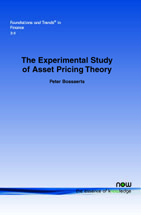The Experimental Study of Asset Pricing Theory
By Peter Bossaerts, California Institute of Technology, USA and Ecole Polytechnique Fédérale Lausanne, Switzerland, pbs@hss.caltech.edu
Abstract
This monograph sets the stage for experiments by first examining a sample data set that looks very much like the typical historical data one gathers from the field, only it was actually generated in the laboratory so that we know what really went on. The example demonstrates how misleading the traditional analysis can be. It then moves on to discuss risk aversion, since asset pricing theory builds on risk aversion. The issue is — is there enough risk aversion in the laboratory given typical levels of compensation? Asset pricing theory also builds on competitive markets and competitive equilibrium, but these are actually purely abstract notions, without any suggestion of how to generate them in practice. The article builds on the path-breaking experimental work of Vernon Smith and Charles Plott who demonstrated that certain trading institutions indeed allow us to bring about competitive markets and competitive equilibrium. The author presents the main findings — first concerning simple static asset pricing models, moving on to dynamic pricing theory, and the implications of ambiguity aversion. Asset pricing theory rarely discusses how markets reach equilibrium, but experiments shed new light on price behavior during equilibration, as well as on off-equilibrium allocation dynamics. This monograph also examines information aggregation and competitive markets for loan and insurance contracts, where adverse selection may preclude equilibration, and even when not, the resulting allocations may be Pareto sub-optimal.
The Experimental Study of Asset Pricing Theory
The Experimental Study of Asset Pricing Theory is the first review of experimentation in asset pricing, which is both rare and novel. The goal of experimentation is twofold. First, experimentation is meant to evaluate the science behind asset pricing theory. Second, the goal of experimentation is to come to a deeper understanding of asset pricing theory. The Experimental Study of Asset Pricing Theory sets the stage by first examining a sample data set that looks very much like the typical data set finance scholars gather from the field, only it was actually generated in the laboratory. It then moves on to discuss risk aversion, since asset pricing theory builds on risk aversion. The issue is – is there enough risk aversion in the laboratory given typical levels of compensation? Asset pricing theory also builds on competitive equilibrium, but competitive equilibrium is an abstract notion; how can we get to it in the laboratory? The author builds on the path-breaking work of Vernon Smith and Charlie Plott who demonstrated that certain trading institutions indeed allow us to generate competitive equilibrium. The author the presents the main findings – first concerning simple static asset pricing models, moving on to dynamic pricing theory, and the implications of ambiguity aversion. Asset pricing theory rarely discusses how markets reach equilibrium, but experiments shed new light on price behavior during equilibration, as well as on off-equilibrium allocation dynamics. It also examines information aggregation and markets for loan and insurance contracts, where adverse selection may preclude equilibration, and even when not, the resulting allocations may be Pareto sub-optimal.
